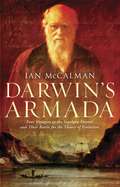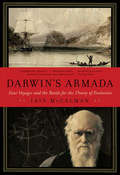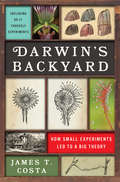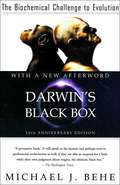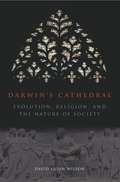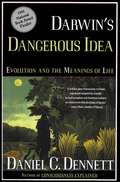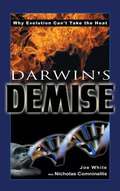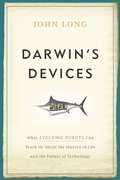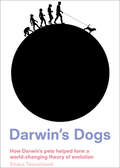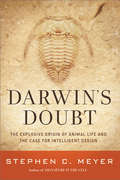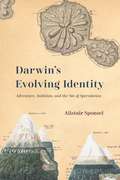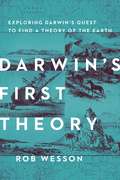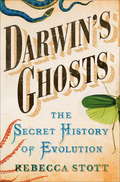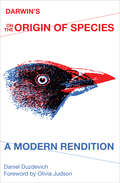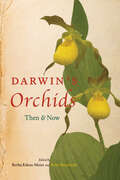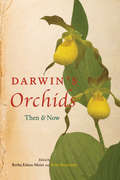- Table View
- List View
Darwin's Armada: Four Voyagers to the Southern Oceans and Their Battle for the Theory of Evolution
by Iain MccalmanProving that good science (and good history) will make for a good story, McCalman (History, University of Sydney) presents a distinctive version of the beginnings of evolutionary biology during the 19th century. Weaving together the stories of naturalists Charles Darwin, Joseph Hooker, Thomas Huxley, and Alfred Wallace, the author shows how these men's scientific discoveries laid the groundwork for the theory of evolution, and how the support of Hooker, Huxley, and Wallace--the "armada" of the book's title--was essential to Darwin's efforts to persuade the scientific community that the theory of evolution was sound science. The book is especially good at showing how each scientist's ideas on evolution developed as a result of their field work, and how their similar field experiences in the Southern Hemisphere helped make them scientific allies. McCalman's engaging prose is complemented by 16 pages of illustrations, many of which are not the "usual suspects" found in books on Darwin or evolution. About as rip-roaring a science history as a reader could want, McCalman's book will have broad appeal. Annotation ©2010 Book News, Inc. , Portland, OR (booknews. com)
Darwin's Armada: Four Voyages and the Battle for the Theory of Evolution
by Iain Mccalman"Sparkling . . . an extraordinary true-adventure story, complete with trials, tribulations and moments of exultation."--Kirkus Reviews, starred review Award-winning cultural historian Iain McCalman tells the stories of Charles Darwin and his staunchest supporters: Joseph Hooker, Thomas Huxley, and Alfred Wallace. Beginning with the somber morning of April 26, 1882--the day of Darwin's funeral--Darwin's Armada steps back and recounts the lives and scientific discoveries of each of these explorers, who campaigned passionately in the war of ideas over evolution and advanced the scope of Darwin's work.
Darwin's Backyard: How Small Experiments Led To A Big Theory
by James T. CostaDarwin’s Backyard goes beyond the portrait of Charles Darwin as a brilliant thinker to concentrate on him as a nimble experimenter delving into some of evolution’s great mysteries. James T. Costa takes readers on a journey from Darwin’s childhood through his voyage on the HMS Beagle where his ideas on evolution began. We then follow Darwin to Down House, his bustling home of forty years, where he kept porcupine quills at his desk to dissect barnacles, maintained a flock of sixteen pigeon breeds in the dovecote, and cultivated climbing plants in the study, and to Bournemouth, where on one memorable family vacation he fed carnivorous plants in the soup dishes. Using his garden and greenhouse, the surrounding meadows and woodlands, and even taking over the cellar, study, and hallways of his home-turned-field-station, Darwin tested ideas of his landmark theory of evolution with an astonishing array of hands-on experiments that could be done on the fly, without specialized equipment. He engaged naturalists, friends, neighbors, family servants, and even his children, nieces, nephews, and cousins as assistants in these experiments, which involved everything from chasing bees and tempting fish to eat seeds to serenading earthworms. From the experiments’ results, he plumbed the laws of nature and evidence for the revolutionary arguments of On the Origin of Species and his other watershed works. Beyond Darwin at work, we accompany him against the backdrop of his enduring marriage, chronic illness, grief at the loss of three children, and joy in scientific revelation. This unique glimpse of Darwin’s life introduces us to an enthusiastic correspondent, crowd-sourcer, family man, and, most of all, an incorrigible observer and experimenter. Includes directions for eighteen hands-on experiments, for home, school, yard, or garden.
Darwin's Black Box: The Biochemical Challenge to Evolution
by Michael J. BeheThe groundbreaking, "seminal work" (Time) on intelligent design that dares to ask, was Darwin wrong? In 1996, Darwin's Black Box helped to launch the intelligent design movement: the argument that nature exhibits evidence of design, beyond Darwinian randomness. It sparked a national debate on evolution, which continues to intensify across the country. From one end of the spectrum to the other, Darwin's Black Box has established itself as the key intelligent design text -- the one argument that must be addressed in order to determine whether Darwinian evolution is sufficient to explain life as we know it. In a major new Afterword for this edition, Behe explains that the complexity discovered by microbiologists has dramatically increased since the book was first published. That complexity is a continuing challenge to Darwinism, and evolutionists have had no success at explaining it. Darwin's Black Box is more important today than ever.
Darwin's Cathedral: Evolution, Religion, and the Nature of Society
by David Sloan WilsonOne of the great intellectual battles of modern times is between evolution and religion. Until now, they have been considered completely irreconcilable theories of origin and existence. David Sloan Wilson's Darwin's Cathedral takes the radical step of joining the two, in the process proposing an evolutionary theory of religion that shakes both evolutionary biology and social theory at their foundations. The key, argues Wilson, is to think of society as an organism, an old idea that has received new life based on recent developments in evolutionary biology. If society is an organism, can we then think of morality and religion as biologically and culturally evolved adaptations that enable human groups to function as single units rather than mere collections of individuals? Wilson brings a variety of evidence to bear on this question, from both the biological and social sciences. From Calvinism in sixteenth-century Geneva to Balinese water temples, from hunter-gatherer societies to urban America, Wilson demonstrates how religions have enabled people to achieve by collective action what they never could do alone. He also includes a chapter considering forgiveness from an evolutionary perspective and concludes by discussing how all social organizations, including science, could benefit by incorporating elements of religion. Religious believers often compare their communities to single organisms and even to insect colonies. Astoundingly, Wilson shows that they might be literally correct. Intended for any educated reader, Darwin's Cathedral will change forever the way we view the relations among evolution, religion, and human society.
Darwin's Cathedral: Evolution, Religion, and the Nature of Society
by David Sloan WilsonA study examining the connection between religious faith and human evolution.“Thoughtful and provocative. . . . Wilson turns to religion, which, he claims, can be explained only by group selection. According to Wilson, a religion is the human equivalent of a pack of lions: by cooperating as a group, people attain benefits beyond their reach as individuals.”―Times Literary Supplement, Book of the YearOne of the great intellectual battles of modern times is between evolution and religion. Until now, they have been considered completely irreconcilable theories of origin and existence. David Sloan Wilson's Darwin's Cathedral takes the radical step of joining the two, in the process proposing an evolutionary theory of religion that shakes both evolutionary biology and social theory at their foundations.The key, argues Wilson, is to think of society as an organism, an old idea that has received new life based on recent developments in evolutionary biology. If society is an organism, can we then think of morality and religion as biologically and culturally evolved adaptations that enable human groups to function as single units rather than mere collections of individuals? Wilson brings a variety of evidence to bear on this question, from both the biological and social sciences. From Calvinism in sixteenth-century Geneva to Balinese water temples, from hunter-gatherer societies to urban America, Wilson demonstrates how religions have enabled people to achieve by collective action what they never could do alone. He also includes a chapter considering forgiveness from an evolutionary perspective and concludes by discussing how all social organizations, including science, could benefit by incorporating elements of religion.Religious believers often compare their communities to single organisms and even to insect colonies. Astoundingly, Wilson shows that they might be literally correct. Intended for any educated reader, Darwin's Cathedral will change forever the way we view the relations among evolution, religion, and human society.“As always, Wilson writes well and clearly and in a stimulating and provocative style. The book is interesting and important, and there can be no higher praise. . . . I applaud the approach taken by Wilson, and I urge you to read Darwin’s Cathedral.” — Science“Wilson's book is more than just an attempt to understand religion. Even to readers with no interest in either religion or science, his book can serve as a model of how to discuss controversial subjects honestly.” —New York Review of Books
Darwin's Dangerous Idea
by Daniel C. DennettIn a book that is both groundbreaking and accessible, Daniel C. Dennett, whom Chet Raymo of The Boston Globe calls "one of the most provocative thinkers on the planet," focuses his unerringly logical mind on the theory of natural selection, showing how Darwin's great idea transforms and illuminates our traditional view of humanity's place in the universe. Dennett vividly describes the theory itself and then extends Darwin's vision with impeccable arguments to their often surprising conclusions, challenging the views of some of the most famous scientists of our day.
Darwin's Dangerous Idea: Evolution and the Meanings of Life
by Daniel Clement DennettDennett demonstrates the power of the theory of natural selection and shows how Darwin's idea transforms and illuminates our traditional view of our place in the universe.
Darwin's Demise
by Joe White Nicholas ComninellisFor people confused by the contradictory messages they hear from secular science and church teaching, evolution can be intimidating. The truth is that Darwin's ideas are based upon faulty science, and that creationists have solid evidence to support their claims. Finally, a brilliant defense of Genesis and the Bible's teaching about origins is waiting for those who are soon to understand how Darwinism is fraudulent faith masquerading as science. Authors Joe White and Nicholas Comninellis have a passion for truth, and for sharing it with students and their parents. In Darwin's Demise,they succeed in showing why real science is burning down the House of Darwin.
Darwin's Devices: What Evolving Robots Can Teach Us About the History of Life and the Future of Technology
by John LongWhat happens when we let robots play the game of life? The challenge of studying evolution is that the history of life is buried in the past--we can't witness the dramatic events that shaped the adaptations we see today. But biorobotics expert John Long has found an ingenious way to overcome this problem: he creates robots that look and behave like extinct animals, subjects them to evolutionary pressures, lets them compete for mates and resources, and mutates their 'genes'. In short, he lets robots play the game of life. In Darwin's Devices, Long tells the story of these evolving biorobots--how they came to be, and what they can teach us about the biology of living and extinct species. Evolving biorobots can replicate creatures that disappeared from the earth long ago, showing us in real time what happens in the face of unexpected environmental challenges. Biomechanically correct models of backbones functioning as part of an autonomous robot, for example, can help us understand why the first vertebrates evolved them. But the most impressive feature of these robots, as Long shows, is their ability to illustrate the power of evolution to solve difficult technological challenges autonomously--without human input regarding what a workable solution might be. Even a simple robot can create complex behavior, often learning or evolving greater intelligence than humans could possibly program. This remarkable idea could forever alter the face of engineering, design, and even warfare. An amazing tour through the workings of a fertile mind, Darwin's Devices will make you rethink everything you thought you knew about evolution, robot intelligence, and life itself.
Darwin's Dogs: How Darwin's Pets Helped Form a World-Changing Theory of Evolution
by Emma TownshendIf you have ever looked at a dog waiting to go for a walk and thought there was something age-old and almost human about his sad expression, you&’re not alone; Charles Darwin did exactly the same. But Darwin didn&’t just stop at feeling that there was some connection between humans and dogs. English gentleman naturalist, great pioneer of the theory of evolution and incurable dog-lover, Darwin used his much-loved dogs as evidence in his continuing argument that all animals including human beings, descended from one common ancestor. From his fondly written letters home enquiring after the health of family pets to his profound scientific consideration of the ancestry of the domesticated dog, Emma Townshend looks at Darwin&’s life and work from a uniquely canine perspective.
Darwin's Doubt: The Explosive Origin of Animal Life and the Case for Intelligent Design
by Stephen C. MeyerCharles Darwin knew that there was a significant event in the history of life that his theory did not explain. In what is known today as the "Cambrian explosion," 530 million years ago many animals suddenly appeared in the fossil record without apparent ancestors in earlier layers of rock. In Darwins Doubt Stephen C. Meyer tells the story of the mystery surrounding this explosion of animal life--a mystery that has intensified, not only because the expected ancestors of these animals have not been found, but also because scientists have learned more about what it takes to construct an animal. Expanding on the compelling case he presented in his last book, Signature in the Cell, Meyer argues that the theory of intelligent design--which holds that certain features of the universe and of living things are best explained by an intelligent cause, not an undirected process such as natural selection--is ultimately the best explanation for the origin of the Cambrian animals.
Darwin's Enigma
by Luther SunderlandEvolutionists have long known that Charles Darwin's original argument against his own theory - that a lack of fossil evidence of transitional forms would reduce him to an embarrassing footnote in history - was screamingly true. No legitimate fossil evidence exists that shows one species changing into another. This startling realization led Luther Sunderland to an exhaustive search of the subject, and his findings show clearly that evolution is a theory in disarray. From his own interviews with leading evolutionists, and an examination of the fossil evidence, Sunderland shows that the Enigma of Darwin's anti-God philosophy is that the facts show it is anything but rock-solid. Before is death in 1987, Luther Sunderland had garnered the respect of creationists worldwide for his investigative writing of the evolution controversy. After obtaining an engineering degree from Penn State University, Sunderland spent 30 years developing automatic flight control systems for the General Electric Company. DARWIN'S ENIGMA remains on intensely popular work on the theory of origins.
Darwin's Evolving Identity: Adventure, Ambition, and the Sin of Speculation
by Alistair SponselWhy—against his mentor’s exhortations to publish—did Charles Darwin take twenty years to reveal his theory of evolution by natural selection? In Darwin’s Evolving Identity, Alistair Sponsel argues that Darwin adopted this cautious approach to atone for his provocative theorizing as a young author spurred by that mentor, the geologist Charles Lyell. While we might expect him to have been tormented by guilt about his private study of evolution, Darwin was most distressed by harsh reactions to his published work on coral reefs, volcanoes, and earthquakes, judging himself guilty of an authorial “sin of speculation.” It was the battle to defend himself against charges of overzealous theorizing as a geologist, rather than the prospect of broader public outcry over evolution, which made Darwin such a cautious author of Origin of Species. Drawing on his own ambitious research in Darwin’s manuscripts and at the Beagle’s remotest ports of call, Sponsel takes us from the ocean to the Origin and beyond. He provides a vivid new picture of Darwin’s career as a voyaging naturalist and metropolitan author, and in doing so makes a bold argument about how we should understand the history of scientific theories.
Darwin's First Theory: Exploring Darwin's Quest For A Theory Of Earth
by Rob WessonAn acclaimed geologist leads the reader on an adventure through the landscape that absorbed and inspired Charles Darwin. Everybody knows—or thinks they know—Charles Darwin, the father of evolution and the man who altered the way we view our place in the world. But what most people do not know is that Darwin was on board the HMS Beagle as a geologist—on a mission to examine the land, not flora and fauna. Retracing Darwin’s footsteps in South America and beyond, geologist Rob Wesson treks across the Andes, cruises waters charted by the Beagle, hunts for fossils in Uruguay and Argentina, and explores sites of long vanished glaciers in Scotland and Wales. As he follows Darwin’s path—literally and intellectually—Wesson experiences the land as Darwin did, engages with his observations, and tackles the same questions Darwin had about our ever-changing Earth. Upon his return from his five-year journey aboard the Beagle, after examining the effects of earthquakes, tsunamis, volcanic eruptions, and more, Darwin conceived his theory of subsidence and uplift‚—his first theory. These concepts and attitudes—the vastness of time; the enormous cumulative impact of almost imperceptibly slow change; change as a constant feature of the environment—underlie Darwin’s subsequent discoveries in evolution. And this peculiar way of thinking remains vitally important today as we enter the human-dominated Anthropocene age. Expertly interweaving science and adventure, Darwin’s First Theory is a riveting and revelatory journey around the world with one of the greatest scientific minds in history.
Darwin's Ghosts: The Secret History of Evolution
by Rebecca StottChristmas, 1859. Just one month after the publication of On the Origin of Species, Charles Darwin received an unsettling letter. He had expected criticism; in fact, letters were arriving daily, most expressing outrage and accusations of heresy. But this letter was different. It accused him of failing to acknowledge his predecessors, of taking credit for a theory that had already been discovered by others. Darwin realized that he had made an error in omitting from Origin of Species any mention of his intellectual forebears. Yet when he tried to trace all of the natural philosophers who had laid the groundwork for his theory, he found that history had already forgotten many of them. Darwin's Ghosts tells the story of the collective discovery of evolution, from Aristotle, walking the shores of Lesbos with his pupils, to Al-Jahiz, an Arab writer in the first century, from Leonardo da Vinci, searching for fossils in the mine shafts of the Tuscan hills, to Denis Diderot in Paris, exploring the origins of species while under the surveillance of the secret police, and the brilliant naturalists of the Jardin de Plantes, finding evidence for evolutionary change in the natural history collections stolen during the Napoleonic wars. Evolution was not discovered single-handedly, Rebecca Stott argues, contrary to what has become standard lore, but is an idea that emerged over many centuries, advanced by daring individuals across the globe who had the imagination to speculate on nature's extraordinary ways, and who had the courage to articulate such speculations at a time when to do so was often considered heresy. With each chapter focusing on an early evolutionary thinker, Darwin's Ghosts is a fascinating account of a diverse group of individuals who, despite the very real dangers of challenging a system in which everything was presumed to have been created perfectly by God, felt compelled to understand where we came from. Ultimately, Stott demonstrates, ideas--including evolution itself--evolve just as animals and plants do, by intermingling, toppling weaker notions, and developing over stretches of time. Darwin's Ghosts presents a groundbreaking new theory of an idea that has changed our very understanding of who we are.From the Hardcover edition.
Darwin's Gift
by Francisco AyalaWith the publication in 1859 of On the Origin of Species by Means of Natural Selection, Charles Darwin established evolution by common descent as the dominant scientific explanation for nature's diversity. This was to be his gift to science and society; at last, we had an explanation for how life came to be on Earth. Scientists agree that the evolutionary origin of animals and plants is a scientific conclusion beyond reasonable doubt. They place it beside such established concepts as the roundness of the earth, its revolution around the sun, and the molecular composition of matter. That evolution has occurred, in other words, is a fact. Yet as we approach the bicentennial celebration of Darwin's birth, the world finds itself divided over the truth of evolutionary theory. Consistently endorsed as "good science" by experts and overwhelmingly accepted as fact by the scientific community, it is not always accepted by the public, and our schools continue to be battlegrounds for this conflict. From the Tennessee trial of a biology teacher who dared to teach Darwin's theory to his students in 1925 to Tammy Kitzmiller's 2005 battle to keep intelligent design out of the Dover district schools in Pennsylvania, it's clear that we need to cut through the propaganda to quell the cacophony of raging debate. With the publication of Darwin's Gift, a voice at once fresh and familiar brings a rational, measured perspective to the science of evolution. An acclaimed evolutionary biologist with a background in theology, Francisco Ayala offers clear explanations of the science, reviews the history that led us to ratify Darwin's theories, and ultimately provides a clear path for a confused and conflicted public.
Darwin's Island: The Galapagos in the Garden of England
by Professor Steve JonesThe Origin of Species is the most famous book in science but its stature tends to obscure the genius of Charles Darwin's other works. The Beagle voyage, too, occupied only five of the fifty years of his career. He spent only five weeks on the Galapagos and on his return never left Britain again. Darwin wrote six million words, in nineteen books and innumerable letters, on topics as different as dogs, barnacles, insect-eating plants, orchids, earthworms, apes and human emotion. Together, they laid the foundations of modern biology.In this beautifully written, witty and illuminating book, Steve Jones explores the domestic Darwin, the sage of Kent, and brings his work up to date. Great Britain was Charles Darwin's other island, its countryside as much, or more, a place of discovery than had been the Galapagos. It traces the great naturalist's second journey across its modest landscape: a voyage not of the body but of the mind.
Darwin's Island: The Galapagos in the Garden of England
by Steve JonesThe Origin of Species is the most famous book in science but its stature tends to obscure the genius of Charles Darwin's other works. The Beagle voyage, too, occupied only five of the fifty years of his career. He spent only five weeks on the Galapagos and on his return never left Britain again. Darwin wrote six million words, in nineteen books and innumerable letters, on topics as different as dogs, barnacles, insect-eating plants, orchids, earthworms, apes and human emotion. Together, they laid the foundations of modern biology.In this beautifully written, witty and illuminating book, Steve Jones explores the domestic Darwin, the sage of Kent, and brings his work up to date. Great Britain was Charles Darwin's other island, its countryside as much, or more, a place of discovery than had been the Galapagos. It traces the great naturalist's second journey across its modest landscape: a voyage not of the body but of the mind.
Darwin's Love of Life: A Singular Case of Biophilia
by Karen L. HarelBiophilia—the love of life—encompasses the drive to survive, a sense of kinship with all life-forms, and an instinct for beauty. In this unconventional book, Kay Harel uses biophilia as a lens to explore Charles Darwin’s life and thought in deeply original ways. In a set of interrelated essays, she considers how the love of life enabled him to see otherwise unseen evolutionary truths.Harel traces the influence of biophilia on Darwin’s views of dogs, facts, thought, emotion, and beauty, informed by little-known material from his private notebooks. She argues that much of what Darwin described, envisioned, and felt was biophilia in action. Closing the book is a profile of Darwin’s marriage to Emma Wedgwood, his first cousin, a woman gifted in music and medicine who shared her husband’s love of life.Harel’s meditative, playful, and lyrical musings draw on the tools of varied disciplines—aesthetics, astronomy, biology, evolutionary theory, history of science, philosophy, psychiatry, and more—while remaining unbounded by any particular one. Taking unexpected paths to recast a figure we thought we knew, this book offers readers a different Darwin: a man full of love, joy, awe, humility, curiosity, and a zest for living.
Darwin's Man in Brazil: The Evolving Science of Fritz Müller
by David A. WestFritz Müller (1821-1897), though not as well known as his colleague Charles Darwin, belongs in the cohort of great nineteenth-century naturalists. Recovering Müller's legacy, David A. West describes the close intellectual kinship between Müller and Darwin and details a lively correspondence that spanned seventeen years. The two scientists, despite living on separate continents, often discussed new research topics and exchanged groundbreaking ideas that unequivocally moved the field of evolutionary biology forward. Müller was unique among naturalists testing Darwin's theory of natural selection because he investigated an enormous diversity of plants and animals, corresponded with prominent scientists, and published important articles in Germany, England, the United States, and Brazil. Darwin frequently praised Müller's powers of observation and interpretation, counting him among those scientists whose opinions he valued most. Despite the importance and scope of his work, however, Müller is known for relatively few of his discoveries. West remedies this oversight, chronicling the life and work of this remarkable and overlooked man of science.
Darwin's Most Wonderful Plants: A Tour of His Botanical Legacy
by Ken ThompsonFor many people, the story of Charles Darwin goes like this: he ventured to the Galapagos Islands on the Beagle, was inspired by the biodiversity of the birds he saw there, and immediately returned home to write his theory of evolution. But this simplified narrative is inaccurate and lacking: it leaves out a major part of Darwin’s legacy. He published On the Origin of Species nearly thirty years after his voyages. And much of his life was spent experimenting with and observing plants. Darwin was a brilliant and revolutionary botanist whose observations and theories were far ahead of his time. With Darwin’s Most Wonderful Plants, biologist and gardening expert Ken Thompson restores this important aspect of Darwin’s biography while also delighting in the botanical world that captivated the famous scientist. Thompson traces how well Darwin’s discoveries have held up, revealing that many are remarkably long-lasting. Some findings are only now being confirmed and extended by high-tech modern research, while some have been corrected through recent analysis. We learn from Thompson how Darwin used plants to shape his most famous theory and then later how he used that theory to further push the boundaries of botanical knowledge. We also get to look over Darwin’s shoulder as he labors, learning more about his approach to research and his astonishing capacity for hard work. Darwin’s genius was to see the wonder and the significance in the ordinary and mundane, in the things that most people wouldn’t look at twice. Both Thompson and Darwin share a love for our most wonderful plants and the remarkable secrets they can unlock. This book will instill that same joy in casual gardeners and botany aficionados alike.
Darwin's On the Origin of Species: A Modern Rendition
by Daniel DuzdevichAn essential new edition of the 19th-century scientific masterpiece that translates Darwin&’s Victorian prose into modern English: &“Most useful&” (Walter Brock, Columbia University). Charles Darwin&’s most famous book On the Origin of Species is without question one of the most important books ever written. Yet many students have great difficulty understanding it. While even the grandest works of Victorian English can be a challeng for modern readers, Darwin&’s dense scientific prose is especially difficult to navigate. For an era in which Darwin is more talked about than read, doctoral student Daniel Duzdevich offers a clear, modern English rendering of Darwin&’s first edition. Neither an abridgement nor a summary, this version might best be described as a translation for contemporary English readers. A monument to reasoned insight, the Origin illustrates the value of extensive reflection, carefully gathered evidence, and sound scientific reasoning. By removing the linguistic barriers to understanding and appreciating the Origin, this edition brings 21st-century readers into closer contact with Darwin&’s revolutionary ideas.
Darwin's Orchids: Then & Now
by Retha Edens-Meier and Peter BernhardtFor biologists, 2009 was an epochal year: the bicentennial of Charles Darwin’s birth and the 150th anniversary of the publication of a book now known simply as The Origin of Species. But for many botanists, Darwin’s true legacy starts with the 1862 publication of another volume: On the Various Contrivances by Which British and Foreign Orchids Are Fertilised by Insects and on the Good Effects of Intercrossing, or Fertilisation of Orchids. This slim but detailed book with the improbably long title was the first in a series of plant studies by Darwin that continues to serve as a global exemplar in the field of evolutionary botany. In Darwin’s Orchids, an international group of orchid biologists unites to celebrate and explore the continuum that stretches from Darwin’s groundbreaking orchid research to that of today. Mirroring the structure of Fertilisation of Orchids, Darwin’s Orchids investigates flowers from Darwin’s home in England, through the southern hemisphere, and on to North America and China as it seeks to address a set of questions first put forward by Darwin himself: What pollinates this particular type of orchid? How does its pollination mechanism work? Will an orchid self-pollinate or is an insect or other animal vector required? And how has this orchid’s lineage changed over time? Diverse in their colors, forms, aromas, and pollination schemes, orchids have long been considered ideal models for the study of plant evolution and conservation. Looking to the past, present, and future of botany, Darwin’s Orchids will be a vital addition to this tradition.
Darwin's Orchids: Then and Now
by Retha Edens-Meier Peter BernhardtFor biologists, 2009 was an epochal year: the bicentennial of Charles Darwin’s birth and the 150th anniversary of the publication of a book now known simply as The Origin of Species. But for many botanists, Darwin’s true legacy starts with the 1862 publication of another volume: On the Various Contrivances by Which British and Foreign Orchids Are Fertilised by Insects and on the Good Effects of Intercrossing, or Fertilisation of Orchids. This slim but detailed book with the improbably long title was the first in a series of plant studies by Darwin that continues to serve as a global exemplar in the field of evolutionary botany. In Darwin’s Orchids, an international group of orchid biologists unites to celebrate and explore the continuum that stretches from Darwin’s groundbreaking orchid research to that of today. Mirroring the structure of Fertilisation of Orchids, Darwin’s Orchids investigates flowers from Darwin’s home in England, through the southern hemisphere, and on to North America and China as it seeks to address a set of questions first put forward by Darwin himself: What pollinates this particular type of orchid? How does its pollination mechanism work? Will an orchid self-pollinate or is an insect or other animal vector required? And how has this orchid’s lineage changed over time? Diverse in their colors, forms, aromas, and pollination schemes, orchids have long been considered ideal models for the study of plant evolution and conservation. Looking to the past, present, and future of botany, Darwin’s Orchids will be a vital addition to this tradition.
